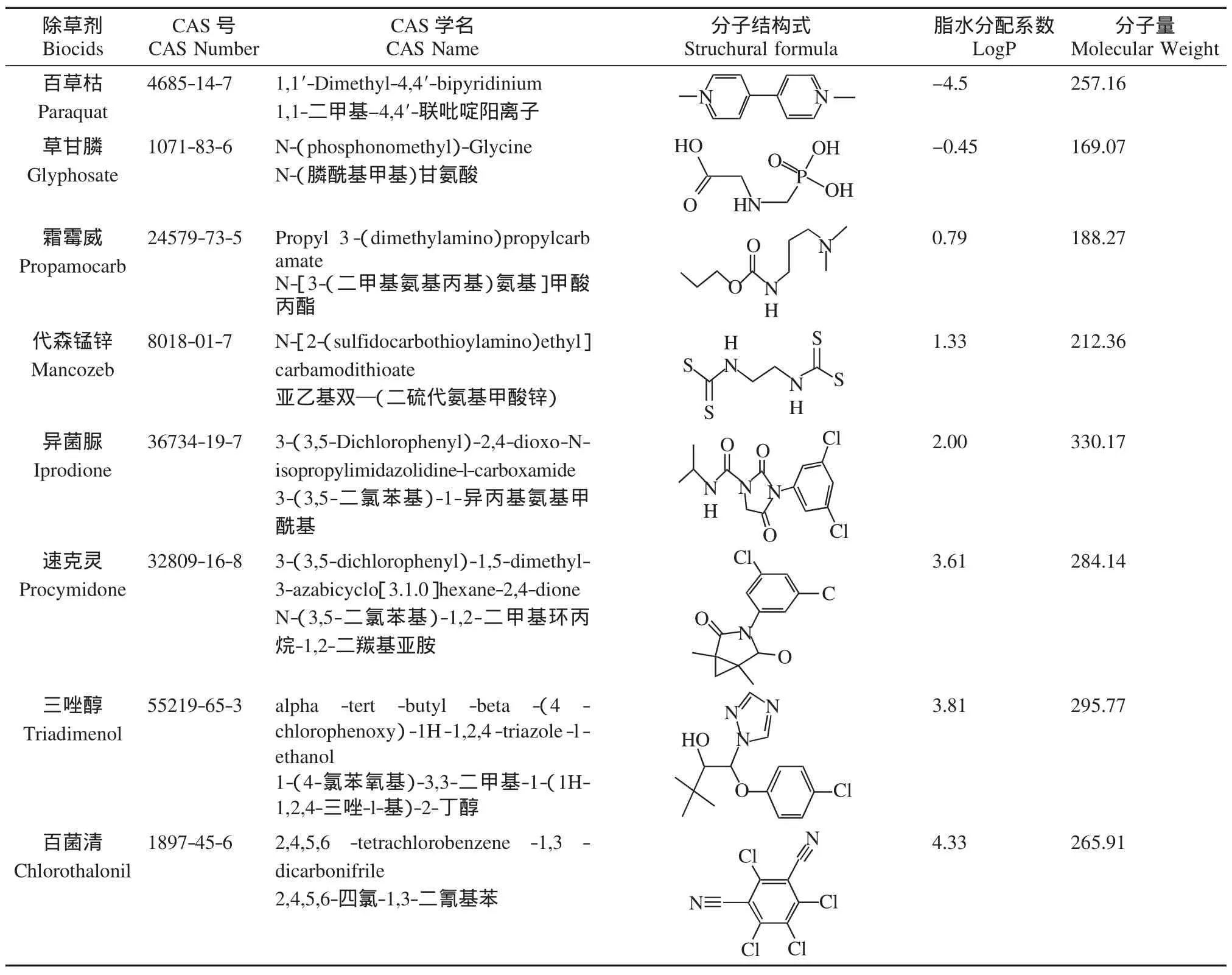8种常见农药对海胆胚胎各发育期的急性毒性
2010-09-12李娇王姮韩昭衡石生宝王永华丁君
李娇,王姮,韩昭衡,石生宝,王永华,丁君
大连海洋大学 农业部海洋水产增养殖学与生物技术重点开放实验室,大连116023
8种常见农药对海胆胚胎各发育期的急性毒性
李娇,王姮,韩昭衡,石生宝,王永华,丁君*
大连海洋大学 农业部海洋水产增养殖学与生物技术重点开放实验室,大连116023
为初步探讨农药对海胆胚胎的急性毒性效应,以虾夷马粪海胆(Strongylocentyotus internedius)为实验材料,研究了 8种常见农药——草甘膦(Glyphosate)、百草枯(Paraquat)、异菌脲(Iprodione)、代森锰锌(Mancozeb)、三唑醇(Triadimenol)、霜霉威(Propamocarb)、百菌清(Chlorothalonil)和速克灵(Procymidone)对海胆胚胎各发育期(二细胞期、四细胞期、上浮囊胚期、原肠期、棱柱幼体期、四腕幼虫期)的半数效应浓度(EC50),并分析了正辛醇/水分配系数(LogP)与EC50的关系.结果显示:1)8种农药对海胆胚胎各发育期均具有一定的急性毒性,以四腕幼虫期为例,8种农药的EC50值分别为草甘膦(3.99mg·L-1)>百草枯(10.38mg·L-1)>代森锰锌(20.77mg·L-1)>速克灵(55.42mg·L-1)>霜霉威(56.09mg·L-1)>异菌脲(86.29mg·L-1)>三唑醇(273.20mg·L-1)>百菌清(647.38mg·L-1).2)LogP与EC50呈现一定的正相关性,即随着LogP的增加,各农药对海胆胚胎的抑制率逐渐降低.
农药;虾夷马粪海胆;胚胎发育;毒性影响
Received 10 December 2009 accepted 16 January 2010
Abstract:Toxic effects of commonly used eight pesticides(Glyphosate,Paraquat,Iprodione,Mancozeb,Triadimenol, Propamocarb,Daconil and Sumilex)on the embryo development of the sea urchin Strongylocentrotus intermedius were evaluated in this work.Toxicity was quantified in terms of the EC50(median effective concentration)on the six early developmental stages of sea urchin embryo(2-cell,4-cell,blastula,gastrula,prism,and 4-arm pluteus).Then the concentration—response curves for each pesticide and the relationship between octanol/water partition coefficient(logP)and EC50of each embryonic development stage were surveyed and analysed.Results showed that 1)all the eight pesticides had toxic effects on the whole embryo development,comparing the EC50values of each pescide at the 4-arm pluteus stage, they were ranked in decreasing order of toxicity EC50as follows:Glyphosate(3.99mg·L-1)>Paraquat(10.38mg·L-1)>Mancozeb(20.77mg·L-1)>Procymidone(55.42mg·L-1)>Propamocarb(56.09mg·L-1)>Iprodione(86.29mg·L-1)>Triadimenol(273.20mg·L-1)>Chlorothalonil(647.38mg·L-1).2)There was a positive correlation between the LogP and EC50of each stage,i.e.as the value of logP increasing,the inhibition rate of the pesticides on the embryos decreased.
Keywords:pesticide;Strongylocentyotus internedius;embryo development;toxicity
1 引言(Introduction)
随着工农业生产的发展,近年来农药的用量不断增加.农药在杀灭病虫害、提高农作物产量的同时也会造成严重的环境污染.研究表明,农药可直接或间接危害人类和其他生物健康,对生殖系统和胚胎发育具有显著影响(Manzo et al.,2005).海洋处于地球的最低处,陆地上的各种污染物最终都将进入海洋(刘维屏,2006).农药可通过河流、降水、地下水等多种途径进入海洋,进而导致浮游动、植物及其他水生生物生理、生态、品种和数量的变化,严重影响海洋生态系统的健康(岳文洁等,2009;何忠文等,2009).因此,研究农药对海洋生物的毒性作用具有重要意义.然而,与陆生生物相比,农药对海洋生物的毒性效应研究尚较为缺乏(孙雪峰等,2009).
海胆属于后口动物,具有个体相对小、生命力强、适应性广、在实验室控制条件下容易饲养、繁殖周期相对短、能分批产卵或连续产卵、产卵量大等特点,在海洋生物学实验中具有广泛应用,并已成为海洋生态毒理学研究的模式生物(Semenova et al.,2006;Berdyshev et al.,1995).胚胎期和幼虫期是海胆生命中对污染物最敏感的时期,目前日本、加拿大和美国等国家已广泛采用海胆胚胎和幼虫来检测重金属的毒性和监测海洋环境的污染状况(His et al.,1999;Ringwood,1991;Carr et al., 1995;Beiras et al.,2003;Bellas et al.,2003;Bellas et al.,2005;Marc et al.,2002;Phillips et al.,2003; Hamdoun et al.,2002;Larrain et al.,1999;Woodworth et al.,1999;Kobayashi and Okamura,2005).然而以海胆胚胎和幼虫为受试对象检测常见农药的毒性尚不多见,国内仅有孙雪峰等(2009)进行了初步研究.本研究在此基础上,以虾夷马粪海胆(Strongylocentyotus internedius)为实验材料,研究了8种农药对海胆胚胎的急性毒性,得到了8种农药对海胆胚胎各发育期的半数效应浓度即EC50值,填补了常见农药对海胆胚胎急性毒性数据的空白,为深入研究农药对海洋生物的影响,制定完善的环境排放标准及风险管理提供了基础毒理学依据.
2 材料与方法(Materials and methods)
2.1 材料
试验用虾夷马粪海胆(Strongylocentyotus internedius)取自大连水产学院重点实验室,壳径3.6~4.8cm,壳高2.2~3.1cm.试验用海水取自大连黑石礁附近海域,经过砂滤池过滤,盐度32.2± 0.3,pH 8.13±0.5.
8种受试农药为草甘膦(Glyphosate)、百草枯(Paraquat)、异菌脲(Iprodione)、代森锰锌(Mancozeb)、三唑醇(Triadimenol)、霜霉威(Propamocarb)、百菌清(Chlorothalonil)和速克灵(Procymidone),购自中国药品生物制品检定所,均为标准品.
2.2 方法
2.2.1 药物浓度的设定
将农药溶于新鲜海水中配得母液,再由母液稀释到实验所需浓度.先按照急性毒性试验方法进行预试验,确定海胆胚胎发育从受精到四腕幼虫全死和不死的剂量范围,根据预实验设定实验浓度:草甘膦(11个梯度)(mg·L-1):0.1、0.5、0.8、1、4、6、8、10、20、30、50;百草枯(8个梯度)(mg·L-1):1、3、5、8、10、20、40、60;异菌脲(7个梯度)(mg·L-1):5、10、30、60、90、120、150;代森锰锌(7个梯度)(mg·L-1):20、60、100、120、150、200、220;三唑醇(7个梯度)(mg·L-1):100、300、500、800、1000、1300、1500;霜霉威(8个梯度)(mg·L-1):1、5、8、10、20、50、70、100;百菌清(6个梯度)(mg·L-1):100、500、1000、3000、5000、7000;速克灵(9个梯度)(mg·L-1):10、20、40、60、80、100、120、150、200.每种药物每个浓度设3个平行,1个对照组,对照组为过滤海水.
2.2.2 配子的获得及人工授精
挑选活力好、大小均一的海胆,采用KCl注射法(KCl浓度为0.5mol·L-1,注射1mL)催产获得精子和卵(常亚青等,2004).将排精的雄海胆换入干的培养皿,以收集纯净的精液原液备用.将排卵的雌海胆放入盛有海水的三角烧瓶中,反口面向下,使海水淹盖生殖孔,让卵直接排入海水中,排出的卵逐渐沉入烧瓶底,显微镜下观察卵子的质量和精子的活性.卵子用筛绢网过滤,将精、卵直接于实验溶液中授精.
2.2.3 毒性实验
受精之后洗卵两次,在盛有200mL实验溶液的250mL烧杯中发育,受精卵的密度大致为100~150个·mL-1,观察胚胎发育过程.实验过程中选取6个发育期进行观察,分别为:二细胞期、四细胞期、上浮囊胚期、原肠期、棱柱幼体期和四腕幼虫期,观察记录各药物对海胆这6个发育期的影响情况.受精后即观察对照组的受精情况,确保实验在90%以上的卵正常受精的情况下进行.本实验条件下,对照组发育到二细胞需要1.5h,发育到四细胞需要2.5h,发育到上浮囊胚需要16.5h,发育到原肠需要28.5h,发育到棱柱幼体需要41h,发育到四腕幼虫需要52h.观察时,每个平行随机抽取100左右的个体,用5%甲醛固定,计数.正常进入各发育期的计为正常个体,发育延滞、畸形及死亡个体计为被抑制个体.
实验过程中间隔性充气,以保证有充足的氧气进入实验水体,水温控制在18℃.
2.3 数据分析
2.3.1 EC50值的计算
检查并统计各实验组海胆胚胎发育期的抑制率.利用SPSS 13.0软件计算农药对海胆胚胎各发育期的EC50值.
2.3.2 LogP与EC50的相关性分析
利用Chmeoffice软件计算出8种农药的LogP值,利用SPSS 13.0软件对LogP与EC50的相关性进行作图并分析.
3 结果与分析(Results and analysis)
3.1 8种农药对海胆胚胎各发育期的急性毒性
3.1.1 EC50值
8种农药对海胆胚胎各发育期的EC50值如表1所示.由表1可见,百菌清对海胆胚胎各发育期的EC50值在8种农药中均为最大;二细胞期EC50值最小的是百草枯;其他各发育期EC50最小的是草甘膦;霜霉威和代森锰锌对于二细胞期的抑制率随浓度变化不明显且低,因此未计算出这两种农药对二细胞期的EC50值.
以四腕幼虫期的EC50值来看,8种农药的毒性大小依次为草甘膦>百草枯>代森锰锌>速克灵>霜霉威>异菌脲>三唑醇>百菌清.

表1 8种农药对海胆胚胎各发育期的EC50值Table 1 EC50values of eight pesticides for the development of sea urchin embryos
3.1.2 海胆胚胎各发育期对农药的敏感性
EC50值随海胆胚胎各发育期的变化如图1所示.由图1可见,随着胚胎的发育,EC50逐渐降低,农药对胚胎的毒性逐渐增强,表明随着海胆胚胎的发育,其对农药的敏感性增强,其中四腕幼虫期最敏感,耐受性最低.

图1 EC50值与海胆胚胎各发育期的关系Fig.1 Relationships between EC50values and sea urchin embryo development periods
海胆胚胎不同发育期对农药的耐受能力不同,可能主要与不同发育期的生理结构有关,上浮囊胚期之前的海胆胚胎有卵膜包裹,对毒性抵抗能力强,原肠期肠道打开,对药物抵抗力下降,到了棱柱期和四腕期胚胎完全暴露于药液中,以至于很小的浓度就能引起抑制.
3.2 LogP值及其与EC50值的相关性分析
8种农药的LogP及结构式如表2所示.
以农药的LogP值为横坐标,以农药对海胆胚胎各发育期的EC50值为纵坐标,对LogP与EC50值的关系作图.如图2所示,随着农药LogP的升高,各农药对不同发育期胚胎的EC50均呈逐渐上升趋势.回归分析表明,原肠期和棱柱期的 EC50与 LogP有较好的正相关关系(p<0.05).
LogP是指平衡状态下化合物在正辛醇和水相中浓度的比值,它反映了化合物在水相和有机相之间的迁移能力,表征的是化合物的亲脂性(何艺兵等,1994).
化合物要对机体产生毒害作用,首先必须通过机体的细胞膜才能与目标分子作用.细胞膜由磷脂双分子层组成,亲脂性的化合物比亲水性的化合物更容易通过这一层细胞膜,因此细胞对药物的吸收通常随分配系数(LogP)的增加而增大(吴义辉等,2000),即LogP值越大,该化合物就越容易通过细胞膜,就可能对有机体造成更大的危害.理论上分子中氯原子数越多,分子的极性越小,其LogP的值越大,它对机体所造成的危害也可能越大(Richard and Hunter,1996).

表2 8种农药的LogP值Table 2 LogP values of eight pesticides

图2 LogP与海胆胚胎各发育期EC50的关系Fig.2 Relationships between LogP values and EC50values during different sea urchin embryo development periods
然而,本实验结果发现EC50值与LogP呈正相关,即随着LogP的增大对海胆胚胎的毒性变小,与上述分析相反,此结果与孙雪峰等(2009)对光棘球海胆胚胎毒性试验中的现象一致.这可能与海胆胚胎细胞特殊的结构和物质组成有关,也可能与农药在海水中与生物作用机制的不同有关(孙雪峰等,2009),还可能与LogP本身有关.分配系数LogP值是对分子整体疏水性质的定量表示,但不能描述分子的局域疏水性,而局域疏水性对于确定受体的活性位点和药物分子的药效团非常重要(Kubinyi,1993).对于海胆胚胎而言,EC50值与农药LogP呈正相关性产生的具体机制目前尚不清楚,有待进一步深入研究.
Beiras R,Bellas J,Fernández N,Lorenzo J I,Cobello-García A.2003.Assessment of coastal marine pollution in Galicia(NW Iberian Peninsula):metalconcentrationsin seawater,sediment and mussels(Mytilus galloprovincialis)versus embryo-larval bioassays using Paracentrotus lividus and Ciona intestinalis[J]. Marine Environmental Research,56(4):531-553
Bellas J,BeirasR,Mariño-Balsa JC,Fernández N.2005.Toxicity of organic compounds to marine invertebrate embryos and larvae:a comparison between the sea urchin embryogenesis bioassay and alternative test species[J].Ecotoxicology,14(3):337-353
Bellas J,Beiras R,Vázquez E.2003.A standardisation of Ciona intestinalis(Chordata,Ascidiacea)embryo-larval bioassay for ecotoxicological studies[J].Water Research,37(19):4613-4622
Berdyshev E V,Vaskovsky V E,Vaschenko M A.1995.Sea urchins—anew modelforPAF research in embryology[J]. Comparative Biochemistry and Physiology,Part B,Biochemistry &Molecular Biology,110(3):629-632
Carr R S,Chapman D C.1995.Comparison of methods for conducting marine and estuarine sediment porewater toxicity tests—Extraction,storage,and handling techniques[J].Archives of Environmental Contamination and Toxicology,28(1):69-77
Chang Y Q,Ding J,Song J.2004.Biological Study and Culture of the Sea Cucumbers and Urchin[M].Beijing:Ocean Press(in Chinese)
Hamdoun A M,Griffin F J,Cherr G N.2002.Tolerance to biodegraded crude in marine invertebrate embryos and larvae is associated with expression of a multixen0biotic resistance transporter[J].Aquatic Toxicology,61(1-2):127-140
He Y B,Zhao Y H,Wang L S,An F C,Mo H H,Yang K W,Liu Y,Yu G,Xu X B.1994.Determination of n-octanol/ water partition coefficient of organic chemicals[J].Environmental Chemistry,13(3):195-196(in Chinese)
He Z W,Xi Y L,Chen Y,Zhang G,Wen X L.2009.Effects of DDT on model ecosystems of ponds[J].Asian Journal of Ecotoxicology,4(4):552-560(in Chinese)
His E,Beiras R,Seaman R N L.1999.The assessment of marine pollution-bioassay with bivalve embryos and larvae[J]. Advances in Marine Biology,37:1-178
Kobayashi N,Okamura H.2005.Effects of heavy metals on sea urchin embryo development.Part 2.Interactive toxic effects of heavy metals in synthetic mine effluents[J].Chemosphere,61(8):1198-1203
Kubinyi H.1993.3D-QSAR in Drug Design:Theory,Methods and Applications[M].Leiden:ESCOMScience Publishers,506-522
Larrain A,Riveros A,Silva J,Bay—Schmith E.1999.Toxicity of metals and pesticides using the sperm cell bioassay with the sea urchin Arbacia spatuligera[J].Bulletin of Environmental Contamination and Toxicology,62(6):749-757
Liu W P.2006.Environmental Chemistry of Pesticide[M].Beijing: Chemical Industry Press(in Chinese)
Manzo S,Buono S,Cremisini C.2006.Toxic effects of irgarol and diuron on sea urchin Paracentrotus lividus early development, fertilization,and offspring quality[J].Archives of Environmental Contamination and Toxicology,51(1):61-68
Marc J,Maguer C,Bellé R,Mulner-Lorillon O.2002.Sharp dose-and time-dependent toxicity of mercuric cholride atthe cellular level in sea urchin embryos[J].Archives of Toxicology, 76(7):388-391
Phillips B M,Nicely P A,Hunt J W,Anderson B S,Tjeerdema R S,Palmer S E,Palmer F H,Puckett H M.2003.Toxicity of cadmium-copper-nickel-zinc mixtures to larval purple sea urchins(Strongylocentrotuspurpuratus)[J].Bulletin ofEnvironmental Contamination and Toxicology,70(3):592-599
Richard A M,Hunter E S.1996.Quantitative structure-activity relationships for the developmental toxicity of haloacetic acids in mammalian whole embryo culture[J].Teratology,53(6):352-360
Ringwood A H.1991.Short-term accumulation of cadmium by embryos,larvae,and adults of a Hawaiian bivalve,Isognomon californicum[J].Journal of Experimental Marine Biology and Ecology,149(1):55-66
Semenova M N,Kiselyov A,Semenov V V.2006.Sea urchin embryo as a model organism for the rapid functional screening of tubulin modulators[J].BioTechniques,40(6):765-774
Sun X F,Ding J,Zhang H,Jia Y P,Wang Y H.2009.Toxic effects of twelve pesticides on the development of sea urchin embryos[J].Asian Journal of Ecotoxicology,4(1):147-151(in Chinese)
Woodworth J G,King C,Miskiewicz A G,Laginestra E,Simon J.1999.Assessment of the comparative toxicity of sewage effluent from 10 sewage treatment plants in the area of Sydney,Australiausing an amphipod and two sea urchin bioassays[J].Marine Pollution Bulletin,39(1-12):174-178
Wu Y H,Wu Y T,He L Y.2000.Application of n-octanol/ water partition coefficient[J].Guangdong Pharmaceutical Journal, 10(4):12-14(in Chinese)
Yue W J,Wang Z H,Wang Q J,Liang W J,Li W J.2009.Toxic effects of cypermethrin on Chattonella marina[J].Asian Journal of Ecotoxicology,4(2):251-257(in Chinese)
中文参考文献
常亚青,丁君,宋坚.2004.海参、海胆生物学研究与养殖[M].北京:海洋出版社
何艺兵,赵元慧,王连生,安凤春,莫汉宏,杨克武,刘晔,余刚,徐晓白.1994.有机化合物正辛醇/水分配系数的测定[J].环境化学,13(3):195-196
何忠文,席贻龙,陈艳,张根,温新利.2009.DDT对池塘模型生态系统的影响[J].生态毒理学报,4(4):552-560
刘维屏.2006.农药环境化学[M].北京:化学工业出版社
孙雪峰,丁君,张辉,贾艳平,王永华.2009.12种常见农药对海胆胚胎发育的毒性影响[J].生态毒理学报,4(1):147-151
吴义辉,伍玉甜,何丽瑜.2000.药物在辛醇-水体系分配系数的应用[J].广东药学,10(4):12-14
岳文洁,王朝晖,王桥军,梁文君,李维杰.2009.氯氰菊酯对海洋卡盾藻的毒性效应[J].生态毒理学报,4(2):251-257
AcuteToxicityofEightPesticideson theDevelopmentofSea Urchin Embryos
LI Jiao,WANG Heng,HAN Zhao-heng,SHI Sheng-bao,WANG Yong-hua,DING Jun*
Key Laboratory of Mariculture&Biotechnology,Ministry of Agriculture,Dalian Ocean University,Dalian 116023
1673-5897(2010)2-255-07
X171.5,X131.3
A
丁君(1973—),女,辽宁辽阳市人,博士,副研究员,主要从事海洋生物技术方面的研究.
2009-12-10 录用日期:2010-01-16
国家高技术研究发展计划(863) 项目(No.2006AA10A411);国家海洋局海洋溢油鉴别与损害评估技术重点实验室开放基金项目
李娇(1986—),女,硕士研究生;通讯作者(Corresponding author),E-mail:dingjunlll9@dlfu.edu.cn
